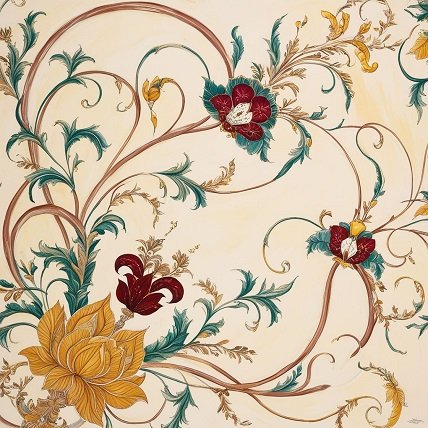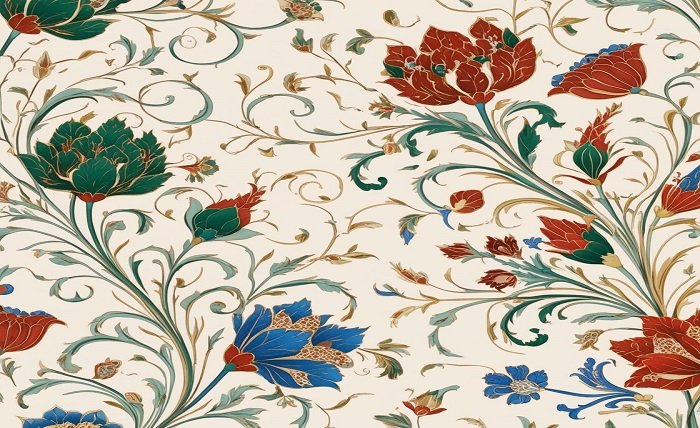Overview
Known for its rich cultural legacy, especially in the areas of art, architecture, and textiles, the Mughal Empire thrived in the Indian subcontinent from the 16th to the 18th century. Floral themes, which graced emperors’ homes and gardens as well as permeated common people’s lives, are among the most stunning examples of Mughal workmanship. These elaborate patterns combine Islamic, Indian, and Persian elements to create a distinctive visual language that still inspires modern designers and artists. We will examine the history, traits, and relevance of Mughal floral motifs themes in this blog article, as well as its continuing influence on modern art and design.
The Origins of Mughal Floral Motifs
A Blending of the Cultures
Rooted in the Persian artistic tradition, the Mughal floral motifs patterns were characterized by elaborate and stylized floral arrangements. The Mughal Empire’s founder, Babur, brought a lot of Persian elements with him when he came to India. This resulted in a distinctive fusion of styles, bringing regional Indian flora and themes into the Persian aesthetic that was already in place. By contracting artists to adapt these designs, the Mughal rulers fostered this synthesis and helped to create a new artistic style.
Nature’s Symbolism
Mughal floral motifs designs had more symbolic connotations beyond just being ornamental. The philosophical principles of life and nature were echoed by flowers, which stood for beauty, love, and transience. For instance, in Indian culture, the lotus, a recurrent theme, represents purity and spiritual enlightenment, whereas the rose frequently denotes love and beauty. The artwork gained depth of meaning from this symbolic complexity, transcending its ornamental status.
Features of Mughal Floral Designs
Detailed Designs
The elaborate designs of Mughal floral motifs, which include a variety of flowers, leaves, and vines, are what define them. The elements of the compositions are frequently placed in a symmetrical or asymmetrical pattern to produce a sense of rhythm and flow, resulting in a harmonious balance. To bring these patterns to life, artists used a painstaking technique that combined brilliant colors and fine lines.
Utilization of Color
A key component of Mughal floral motifs patterns is color. Deep reds, vivid greens, and opulent golds are common examples of the palette’s rich, vivid colors that capture the grandeur of the Mughal court. These colors were created utilizing a variety of methods, including as painting, inlay, and needlework, and were taken from natural sources such minerals and plants.
Different Floral Shapes
The variety of floral shapes seen in Mughal floral motifs patterns spans from accurate depictions of flowers like lotuses, jasmine, and hibiscus to more stylized interpretations. In order to express their creativity and keep a connection to nature, artists combined realistic and abstract aspects.
Mughal Floral Designs in Buildings
Palaces and Gardens
The gardens were very important to the Mughal floral motifs rulers, who saw them as miniature versions of heaven on earth. Their palaces and gardens were beautifully designed with floral designs. Fatehpur Sikri and Shalimar Bagh, two well-known Mughal gardens, include geometric designs embellished with floral patterns that create a calm and peaceful atmosphere.
Accent Pieces
Floral motifs were incorporated into many architectural features of Mughal architecture, such as arches, entrances, and ceilings. The Taj Mahal is home to some of the most stunning marble inlay work, with intricate floral designs that add to the building’s grandeur. These designs represented the link between heaven and earth in addition to being ornamental.

Mughal Floral Patterns in Fabrics
Luxurious Tapestries
The exquisite designs and high quality of Mughal textiles are well known. Fabrics like silk, cotton, and brocade, which were frequently used for tapestries, curtains, and royal clothing, were embellished with floral designs. Block printing, needlework, and weaving were used to produce magnificent items that captured the splendor of the Mughal court.
The Impact of Chintz
Printed or painted fabrics, such as chintzes, gained significant popularity during the Mughal era. These textiles were highly prized both in India and beyond and frequently had intricate floral designs. The 17th-century introduction of chintz to Europe had a big impact on Western textile patterns, which helped people recognize the Mughal creativity on a larger scale.
Mughal Floral Patterns in Modern Design and Painting
Return of Customary Methods
Traditional Mughal floral motifs themes have seen a rebirth in popularity recently, and modern designers and artists have been taking inspiration from this rich history. Many are bringing back traditional methods, including hand-block printing and embroidery, to produce contemporary clothing and interior design interpretations of these themes.
worldwide impact
The appeal of Mughal flower themes has crossed national boundaries and become a staple of international art and design. These elaborate designs are used by fashion designers worldwide into their collections, and interior designers employ them to imbue interiors with an air of sophistication and heritage. This intercultural dialogue highlights the everlasting quality of Mughal aesthetics and enhances the current state of contemporary art.
Summary
Mughal floral motifs patterns bear witness to the creative inventiveness and seamless blending of cultures that characterized the Mughal Empire. Artists and designers all around the world are still enthralled and inspired by their elaborate designs, vibrant colors, and symbolic meanings. It is clear from examining these patterns’ history in modern art and architecture that their beauty endures and serves as a constant reminder of the interdependence of nature, culture, and the arts.
FAQ
Mughal floral motifs: what are they?
Mughal floral motifs are elaborate patterns with a variety of flowers, leaves, and vines that come from the artistic legacy of the Mughal Empire, which combines Islamic, Persian, and Indian elements.
What role do Mughal floral motifs have in Mughal art?
Flowers represent beauty, love, and life’s fleeting nature. They frequently have profound meanings and capture the era’s intellectual and cultural ideals.
What architectural uses did Mughal floral motifs have?
Palaces, gardens, and architectural ornamentation were all embellished with Mughal floral themes, which enhanced the beauty of the buildings and represented the union of heaven and earth.
What is the current relevance of Mughal flower motifs?
Mughal flower themes are a source of inspiration for modern designers and artists, who use them to showcase their classic appeal in fashion, home décor, and other creative industries.
Are fabrics adorned with Mughal floral motifs?
Yes, Mughal flower themes are often employed in textiles, especially in opulent materials like silk and cotton that are used to create tapestries and clothing that capture the splendor of the Mughal court.
Read more about: braves game today

